Blending the E, A and B Chord Progression into the Higher Register
Make one of the most common guitar chord progressions more interesting to play

When you play guitar, it seems like the E, A and B progression shows up everywhere. It’s widely used and particularly conducive to the fretboard and the 12-bar blues chord pattern.
As a result, we use it all the time. And if you’re like me, you might get bored of the formal version of this progression.
For example, if you just tab out the three open chords, you’ll get something like this:
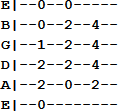
There’s nothing wrong with using this chord progression, but what if we could make it a little more intriguing? We can use the root notes (the low E and A) to build out the same progression in the higher register. Let’s start by setting up our root notes and creating a bass line.
1: Create your Bass Line
You can rearrange the progression later, if you so choose. For now, we’re just going to grab the root notes from each chord in the current order. Here’s the bass line we end up with:

Super easy. Now we need to find corresponding notes on the higher register. Let’s start at the seventh fret on the fifth string, since that note is exactly one octave higher than our low E. We’ll do the same thing with our A chord and then move the B from the fifth string to the first. This way, all of our chords will be played near the seventh and ninth frets, giving us the ability to grab those higher notes in the same spot. When it comes to changing guitar chords, the less movement you can get away with, the better.
2: Add Notes to your New Chords
Let’s go ahead and look at our updated tab.
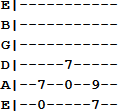
The progression is still the same but, now we’ve got some foundational chord structures to build off of. But these are just power chords and not particularly interesting. How do we fill out the chords? Start by adding the perfect fifth interval for the highest note of each chord. Once you do, your tab should look like this:
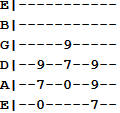
To brighten things up and give our chords a little extra ring, add one more interval to the E and B chord. Here’s our resulting tab:
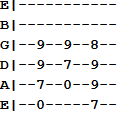
We could leave this chord progression as-is and still have a workable alternative to the open progression that I introduced us to at the beginning of this lesson. But, if we’re honest, this is little more than a few glorified power chords. I want this progression to have some shimmer to it and be more arpeggio-friendly. Here’s the final step to make it happen.
3: Remove the Root Notes and Add Two More Higher Intervals
Remember how we set up our bass line? For a lead guitar player that bass line is assumed. What I mean by that, is that the bass line should be handled by the bass player, meaning you don’t have to carry those low notes. So, to shine up our progression, we’ll simply get rid of them.
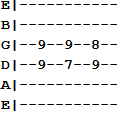
At this point we’re strumming down onto the fourth string (would-be open D) and following through these three dyads. We can follow by adding the two high intervals, open B and E. Our tab then becomes:

And that’s how you get from low-end power and open chords to an upper-register friendly chord progression that you can use as a lead guitar pattern as much as a rhythm guitar pattern. You can even add and remove those other root notes at a whim. Try arpeggiating the chords out. It sounds quite good:

Alternatively:

You can take the shape in whatever direction you want while incorporating as much of the low end or the high end shape as you see fit. That’s why I showed each step going from the lower E, A and B progression to the higher version. If you know the process then you’ll be able to use both extremes and blend them together for more compelling, varied and melodic chord progressions.
Bobby Kittleberger is the founder and editor of Guitar Chalk and a staff writer at Guitar Tricks. You can get in touch with him via email or Twitter.
Get The Pick Newsletter
All the latest guitar news, interviews, lessons, reviews, deals and more, direct to your inbox!
Bobby is the founder of Guitar Chalk, and responsible for developing most of its content. He has worked with leading guitar industry companies including Sweetwater, Ultimate Guitar, Seymour Duncan, PRS, and many others.
“There are so many sounds to be discovered when you get away from using a pick”: Jared James Nichols shows you how to add “snap, crackle and pop” to your playing with banjo rolls and string snaps
Don't let chord inversions bamboozle you. It's simply the case of shuffling the notes around
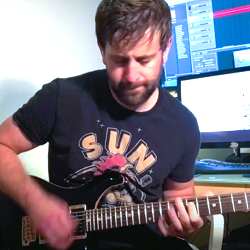







![Joe Bonamassa [left] wears a deep blue suit and polka-dotted shirt and plays his green refin Strat; the late Irish blues legend Rory Gallagher [right] screams and inflicts some punishment on his heavily worn number one Stratocaster.](https://cdn.mos.cms.futurecdn.net/cw28h7UBcTVfTLs7p7eiLe.jpg)


